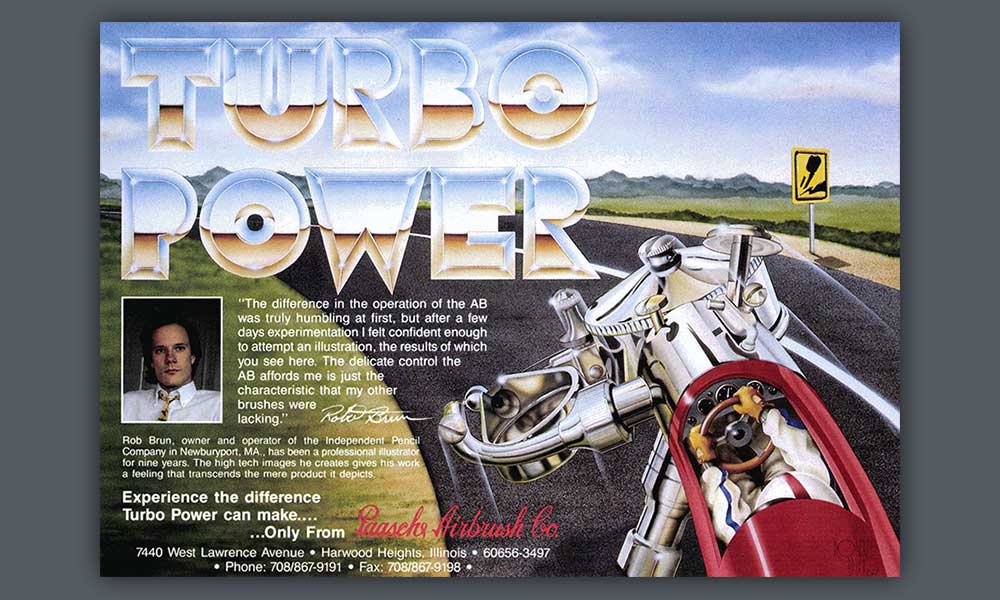Besides being the most complicated looking airbrush, the AB has the unique distinction of being the only turbine airbrush still in use today. The Wold airbrush company had a turbine airbrush years ago. It was tremendously large in comparison to the sleek action brush. The design of the Wold required that the airbrush be held horizontally to the surface of the painting, and the elaborate mechanisms inside the airbrush precluded any hope of easy maintenance. It's no wonder that the Paasche AB is the sole surviving turbine.
The AB is complicated to the uninitiated. Mastery of numerous buttons, screws, levers, and parts is necessary to the proper functioning of the brush. Once acclimated to the various components, however, you will find it a marvelous tool. Unfortunately, the people who most often sell airbrushes know very little about the AB. Even the company's own advertising is short on extolling the virtues of this remarkable instrument. The most often cited comparison of the AB to any other airbrush is by the size of line it can create. A more important comparison is how easy it is to get, maintain, and control a hairline spray. In my opinion, the AB is unparalleled.
Many art supply dealers will tell you that you can get the same quality of line with another brand of airbrush. But can you get the same line with any medium? Can you draw that line without a skip? Can you draw that line very slowly on any surface without creating spiders and without a change in spray quality? I don't think you will be able to. The reason is that all other airbrushes rely on a vacuum to feed the paint into a mixing chamber, where it is mixed with air as it exits the airbrush. The AB has a separate control for the air and the paint feed. The paint itself is fed manually, requiring no vacuum for supply.
A number of alignments and adjustments work in concert to provide the airbrush artist with exactly the amount of paint, quality of spray, and speed of delivery that is desired. With that much control over the medium, the artist is free to work without constantly adjusting his style to the whims of his airbrush. A good place to begin is with the speed control screw located between the power wheel housing and the plunger button, which controls the speed of the turbine. The heart of the turbine is a brass disk with a serrated edge, called the power wheel. In the center of the power wheel is the camshaft. Each end of the camshaft is tapered to fit into a set of bearings, top and bottom. Air is directed through the airbrush past the speed control screw and into the power wheel housing. There the air exits a tiny jet aimed at the serrated edge of the power wheel. The air spins the wheel, which is needle is giving.
The needle is a very thin piece of wire that has a very sharp point at one end. The airbrush comes with a dozen of these needles. One end of the needle is bent downward to fit through a slot in the walking arm and a slot in the body of the airbrush. The needle also has a slight bow to it in two directions so that it will fit snugly under and against the needle guide. How much bow is applied to the needle will affect the resistance the needle gives to the power wheel. The Paasche Airbrush Company shipped all new AB airbrushes with the speed control screw open to maximum and the needle bowed sufficiently to prevent the needle from flying out of the airbrush. This is understandable from a liability point of view. However, if you were to slow the turbine down to a very slow speed, the needle may have an excessive bow, causing too much resistance to the power wheel.
The most efficient use of the AB requires that you be able to work at a comfortable speed. Realizing that fine detail is the most common application of the AB, though certainly not the only one. The turbine should be set at a slow speed for small detail and a fast speed for larger detail. People who are using the AB at the wide-open factory setting might as well be using any other type of airbrush. You need to slow it down and work subtly to create the finest details. You need to adjust the needle so that there is very little resistance to the power wheel but enough to keep it against the needle guide and in the airbrush.
Controlling the speed of the turbine gives the AB an advantage that no other airbrush has. The spinning power wheel drives the walking arm. The walking arm is connected to the needle. The needle is moved back and forth by the walking arm up to 333 times a second (based on the advertised 20,000 rpm of the power wheel). This way the paint is pushed through the needle bearing. That ensures a constant supply of paint. The paint adheres to the needle until it is blown off by a stream of air directed by a second air jet called the air-blast jet. This second air jet is unaffected by any controls on the turbine or needle. As you depress the finger lever on the airbrush, the air is directed in two directions: to the turbine, and to the air-blast jet. The air-blast jet has a control on it that regulates the amount of air that blows the paint off the needle. This control is called the stipple adjuster. By reducing the air to the air-blast jet, you can create a very small, controlled stipple pattern. Something next to impossible on the finest airbrushes.



